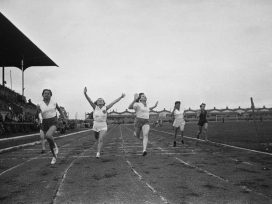A football World Cup on the African continent might be a novelty but it is no accident. The game of football spread more rapidly and gained a firmer foothold here than in other colonised regions of the world – despite the fact that the Bantu languages, which are spoken by more than 400 different ethnic groups in southern and central Africa, do not even have a word for “ball”.
Because of its colonial origins, African football was for a long time controlled by England and France. As in other parts of the world, in Africa it was the British who imported the game. Seamen and colonial soldiers were the first to kick a ball on the continent; later, colonial civil servants, engineers, teachers and traders popularized the game, among the locals as well as the settlers. Schools, both church and state-run, also acted as football missionaries. In Nigeria, for example, football was introduced in the seaport of Calabar by the Hope Waddell Training Institute, which was founded by a group of Jamaican Presbyterians. When the Rev. James Luke was appointed as the new headmaster of the school in 1902, he brought a ball with him to mark the occasion. On 15 June 1904, a barefoot school team played against the crew of the British battleship HMS Thistle and won 3:2.
Football versus the sport of gentlemen
Football chiefly became established in those parts of the British Empire where the presence of the British upper classes was less marked, and where less direct forms of colonial power prevailed. “Gentlemen’s sports” such as cricket and rugby were much more widespread in the protectorate of Uganda, in British East Africa (Kenya) and in Rhodesia, where many British settlers lived, than in West Africa, where the tropical climate was unfavourable to any large-scale British settlement.
Initially, the game spread more rapidly in the British-ruled regions of Africa than in those ruled by France. This was because in the French colonies there was a more rigorous segregation between Europeans and the local population; in addition, sport in general, and football in particular, played only a relatively minor role in French culture at the time.
The first African “footballing power” was Egypt, whose football history began with the arrival of the British occupation force in 1882. British citizens in Cairo organized the first clubs in 1903, and the local residents soon followed suit by founding clubs of their own. The club Al Ahly, which was established in 1907, went on to become one of the most successful and popular in Africa. Dominated by republicans and liberals, Al Ahly was a defiant statement against British colonial rule.
The first independent national football association in Africa was founded in Cairo in 1921. In 1923, Egypt joined FIFA, the first African nation to do so. In 1920 it had been the first to take part in the Olympic Football Tournament, and in 1934 was the first to participate in a World Cup.
The talent scouts of France and Portugal
In one sense, then, England was the “motherland of football” in Africa too. Footballers of African origin first began playing in England after World War II, as waves of colonial immigration began to arrive in Britain; by that time, however, Africans from the French colonies had been plying their trade in the French league for a long time.
The ease with which they were able to do this had to do with the concept of the French nation, which regarded the colonies as an extension of the “motherland” and as part of the Grande Nation. Another factor was that the idea of a “national style” of football developed later in France than it did in England, Germany or Italy. Consequently, the French were able to share the game with the colonial immigrants without the fear of sacrificing their “national soul”.
In their North African colonies, the French became the leading “football missionaries”. South Africa aside, this was the most intensively urbanized and industrialized region in Africa, and had the highest number of European settlers. Since the 1920s, the French government had supported to the promotion of the game, and the Maghreb would be the first region on the continent to enjoy international success.
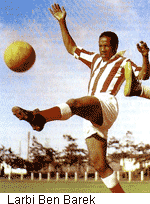 From an early stage there was close integration with domestic football. French clubs discovered that Algeria and Morocco in particular were excellent recruiting grounds. As early as 1938, 147 Africans were playing in the first and second leagues in France. Some of them, such as the Moroccan Larbi Ben Barek, even played for the national French team. Ben Barek, one of the first great black football stars, began his career at Union Sportive Marocaine of Casablanca, before Olympique Marseille brought him to France in 1938. The maestro, famous for his dribbling skills, subsequently laced his boots for Stade Français Paris (under the legendary coach Helenio Herrera) and Atlético Madrid. And when Olympique Marseille ran out against Racing Club of Paris in the French cup final in 1940, another Olympique player was a certain Ahmed Ben Bella. Twenty years later, Ben Bella became President of the independent Republic of Algeria.
From an early stage there was close integration with domestic football. French clubs discovered that Algeria and Morocco in particular were excellent recruiting grounds. As early as 1938, 147 Africans were playing in the first and second leagues in France. Some of them, such as the Moroccan Larbi Ben Barek, even played for the national French team. Ben Barek, one of the first great black football stars, began his career at Union Sportive Marocaine of Casablanca, before Olympique Marseille brought him to France in 1938. The maestro, famous for his dribbling skills, subsequently laced his boots for Stade Français Paris (under the legendary coach Helenio Herrera) and Atlético Madrid. And when Olympique Marseille ran out against Racing Club of Paris in the French cup final in 1940, another Olympique player was a certain Ahmed Ben Bella. Twenty years later, Ben Bella became President of the independent Republic of Algeria.
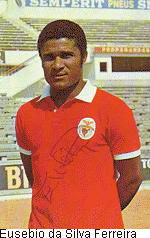 Like France, Portugal was also relatively quick to recognize the “athletic potential” of its colonies. In the 1950s, the leading Portuguese clubs set up a system of scouts in the colonies of Angola and Mozambique, having repeatedly previously come off second best against local teams during propaganda tours. The great Portuguese star of the 1966 World Cup was Eusebio da Silva Ferreira, who had cut his teeth with Sporting Club Lourenço Marques (today’s Maputo) and now played for Benfica Lisbon. Portugal’s success in getting through to the semi-final that year was largely down to Eusebio, who with his nine goals easily won the trophy for the top goal-scorer.
Like France, Portugal was also relatively quick to recognize the “athletic potential” of its colonies. In the 1950s, the leading Portuguese clubs set up a system of scouts in the colonies of Angola and Mozambique, having repeatedly previously come off second best against local teams during propaganda tours. The great Portuguese star of the 1966 World Cup was Eusebio da Silva Ferreira, who had cut his teeth with Sporting Club Lourenço Marques (today’s Maputo) and now played for Benfica Lisbon. Portugal’s success in getting through to the semi-final that year was largely down to Eusebio, who with his nine goals easily won the trophy for the top goal-scorer.
Although by the start of World War II football had become the most popular sport in Africa, its dissemination proceeded much more slowly than it did in Europe (with North Africa being something of an exception). The principal reason for this –alongside the “reserve” of the British colonial top brass, with its preference for the elitist sports – was the low level of urbanization and the underdeveloped education system. Africa also lacked the impetus for the popularization of football that played a crucial role in other countries.
After World War II, decolonization and political independence set off a veritable explosion of sporting activities. For decades, the colonial powers had controlled African football. Now, however, there began a process of more serious and independent organization. The African football association was founded in 1957, adopting the French title Confédération Africaine de Football (CAF).
Football and apartheid in South Africa
As throughout the continent, football in the country hosting this year’s World Cup was introduced by British settlers. The first recorded football match in South Africa kicked off in 1866 in Pietermaritzburg. It was there too that in 1879 the first club was founded – Pietermaritzburg County FC. This was followed in 1882 by three more white-only clubs: the Durban Alphas, the Umegi Stars and the Natal Wasps. Together these formed the Natal Football Association. European businesses backed the founding of football clubs for white workers in Durban, and around the turn of the century in Johannesburg and Cape Town as well.
In 1892 a national association was established, the South African Football Association (SAFA), which was affiliated to the English FA – and open only to whites. After the founding of the Union of South Africa in 1910, the SAFA (later renamed Football Association of South Africa/FASA) became an independent member of FIFA. Yet it was rugby that developed into the dominant sport of the white population, especially after the successful international tours of 1906 and 1912. Today, it is still the Springboks team that attracts the greatest interest among the white citizens of South Africa.
In 1951, a rival association to FASA came into being: the South African Soccer Federation (SASF). Avowedly multiracial, the SASF represented more than 80 per cent of the South African population. Despite this, FIFA chose to give precedence to the pro-apartheid FASA. In 1956, the South African government formally extended racial segregation to cover sport. In 1957, South Africa applied to enter for the first African Cup of Nations, but was excluded after FASA stated that it would on no account put out a mixed-race team.
Though segregated, the white and the black populations lived in close proximity and the “white” game soon found its way into the townships. With the rise of a black urban working class in the mid-twentieth century, football became more and more the sport of the blacks. In particular, the Johannesburg ghetto known as Soweto emerged as the Mecca of black soccer.
Nevertheless, in 1959 FASA created the National Professional Football League (NPFL) as an exclusively white institution. In 1961, a number of officials and clubs left the amateur SASF to form the South African Soccer League (SASL), a multiracial professional league. Fearing it might lose its control over South African football, FASA contacted the municipal authorities, who barred the SASL from using their pitches. Faced with this systematic obstructionism, the SASL could not survive and was disbanded in 1967.
Despite apartheid, mixed teams were not uncommon in South Africa. Blacks, “coloureds” and Indians already played alongside each other in the 1950s. The first white professional team to employ a black player was the Arcadia Shepherds of Pretoria. Not least among the considerations in favour of opening up the harsh apartheid system was the economic one. The mass of the football fans were blacks, and as the Arcadia boss and businessman Saul Sacks put it, “black players keep the public in the stadiums”.
Apartheid under the protection of the FIFA president
Because of its policy of apartheid, FASA was expelled from the CAF in 1961 and was suspended by FIFA in 1964. Despite this, FIFA President Sir Stanley Rous took FASA under his wing for many years. In 1963, after a visit to South Africa, he declared that the members of the “dissident Federation” (he was referring to the SASF) were “quite unsuitable” to represent football in South Africa. In 1968, he accused the representatives of the multiracial South African Non-Racial Olympic Committee (SANROC) of being “more interested in communist politics than football”. Here Rous was using exactly the same argument as the racist FASA officials.
In the end, Rous’ South Africa policy cost him the FIFA presidency. In 1972, FASA, although suspended, requested permission from FIFA to organize an international tournament for amateur national sides. Rous gave his support to the project, but when it became known that South Africa intended to field an all-white team, England, Germany and Brazil withdrew from the competition. The instigator of Brazil’s withdrawal was Rous’ Brazilian rival João Havelange. At the FIFA Congress of 1976, Havelange opposed the Englishman and, with the aid of the African delegates, was elected as the new FIFA boss. At this point, FIFA finally excluded South Africa.
Only after the end of apartheid in 1992 did FIFA readmit South Africa. In 1994, FASA, SASF and two other previously independent associations merged to form the South African Football Association (SAFA), which now represents all the ethnic groups in South Africa. Since 1995, the country has had its own professional league, the Premier Soccer League.
Bafana Bafana
For South Africa’s now predominantly black national team, the post-apartheid era began on 7 July 1992 with a 2:0 victory over Cameroon. Writing up the match in The Sowetan, journalist S’bu Mseleku dubbed the inexperienced team “Bafana Bafana” – a Zulu expression meaning, roughly, “the lads”. The name has stuck.
Unfortunately, this promising start was followed by a series of flops. In 1994, South Africa failed to qualify for either the African Cup of Nations or the World Cup in the USA, at which point William Clive Barker, from Durban, took over as the team’s manager. In a match held to celebrate the inauguration of President Nelson Mandela in May 1994, South Africa defeated Zambia by two goals to one. Thereafter, things began to look up.
Just two years later, the twentieth African Cup of Nations was held in South Africa. It was to prove a triumph for the host nation. South Africa began with a convincing 3:0 victory over Cameroon, went on to defeat Algeria 2:1 in the quarter-finals and Ghana 3:0 in the semis, and ended by beating Tunisia 2:0 in the final in front of 80 000 spectators in Soweto’s Soccer City Stadium. An ironic twist to the story was that the captain Neil Tovey was the first white player in the history of the African Cup of Nations to raise the trophy. Another white-skinned team member was the young central defender Mark Fish, who as a schoolboy was not permitted to play football because his school refused to allow “black soccer”, preferring the white sports of rugby and cricket. Fish went on to play in Europe for Lazio Rome, Bolton Wanderers and Charlton Athletic.
Because of apartheid, South Africa itself was not represented in the finals of a World Cup until 1998. In 2002, the country was eliminated in the preliminary round of the tournament by the smallest possible margin (it was level on points and on goal difference with its nearest rival, but had scored one goal less). After this, Bafana Bafana went downhill fast, failing to qualify for the 2006 World Cup.
Home advantage notwithstanding, the hosts of this year’s world cup have their work cut out against Mexico, Uruguay and France, the other teams in their group. Only recently has a slight improvement of form been evident, with South Africa beating Poland 1:0 in a friendly, and reaching the semi-final of the Confederations Cup in 2009, where a surprisingly strong Bafana Bafana, with an outstanding playmaker in Steven Pienaar (Everton), were narrowly and unluckily defeated by Brazil. All the same, the team is still only 85th in the current FIFA world rankings.
Africa and the football World Cup
Other African sides can claim to have significantly better prospects. The first appearance of an African national team in the World Cup was short-lived. Egypt qualified for the second tournament in 1934 in Italy after winning twice against a team from Palestine. In the finals, however, the North Africans went down 2:4 to Hungary and were eliminated. It was only 36 years later, at the 1970 World Cup in Mexico, that the African continent was once again directly represented at the World Cup finals.
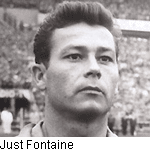 Indirectly, however, Africa had a presence at World Cups in the intervening period thanks to outstanding individual players such as Eusebio or the French player Just Fontaine. Fontaine, who was born in Marrakesh and played for U.S.M. Casablanca from 1951 to 1953, was the top goal-scorer at the 1958 World Cup in Sweden – his tally of 13 goals in a single World Cup has never been bettered to this day. Rachid Mekloufi and Mustafa Zitouni were also in the squad of the Equipe Tricolore for a time, but they left before the start of the World Cup in 1958 to join a team founded by Algerian FLN guerrillas.
Indirectly, however, Africa had a presence at World Cups in the intervening period thanks to outstanding individual players such as Eusebio or the French player Just Fontaine. Fontaine, who was born in Marrakesh and played for U.S.M. Casablanca from 1951 to 1953, was the top goal-scorer at the 1958 World Cup in Sweden – his tally of 13 goals in a single World Cup has never been bettered to this day. Rachid Mekloufi and Mustafa Zitouni were also in the squad of the Equipe Tricolore for a time, but they left before the start of the World Cup in 1958 to join a team founded by Algerian FLN guerrillas.
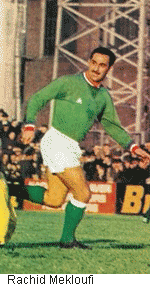 In 1966 the African teams boycotted the qualification rounds, because the European-dominated FIFA had reserved only one single slot for Asia and Africa together. As a result of this protest, a permanent slot was reserved specifically for Africa in the World Cup in Mexico in 1970. Morocco put in a thoroughly respectable performance that year, taking the lead against Germany but eventually losing a close match 1:2. Against Bulgaria they drew 1:1 – gaining the first point ever for an African team in a World Cup. After a catastrophic performance by Zaire at the 1974 World Cup in Germany, a Tunisian team coached by Mejid Chetail (a pupil of the German trainer Hennes Weisweiler) chalked up the first ever victory for an African team in a World Cup in Argentina in 1978. After beating Mexico 3:1, they drew 0:0 against title-holders Germany and were narrowly defeated by Poland 0:1, and so were unluckily eliminated after coming third in their group.
In 1966 the African teams boycotted the qualification rounds, because the European-dominated FIFA had reserved only one single slot for Asia and Africa together. As a result of this protest, a permanent slot was reserved specifically for Africa in the World Cup in Mexico in 1970. Morocco put in a thoroughly respectable performance that year, taking the lead against Germany but eventually losing a close match 1:2. Against Bulgaria they drew 1:1 – gaining the first point ever for an African team in a World Cup. After a catastrophic performance by Zaire at the 1974 World Cup in Germany, a Tunisian team coached by Mejid Chetail (a pupil of the German trainer Hennes Weisweiler) chalked up the first ever victory for an African team in a World Cup in Argentina in 1978. After beating Mexico 3:1, they drew 0:0 against title-holders Germany and were narrowly defeated by Poland 0:1, and so were unluckily eliminated after coming third in their group.
In 1982 in Spain, two African sides took the field for the first time. The Cameroon team was unbeaten, but was eliminated after three draws (including a 1:1 against the eventual champions Italy). Algeria scored a sensational 2:1 victory over the runner-up Germany and overcame Chile 3:2, but lost to Austria 0:2. However in the notorious “non-aggression pact of Gijon”, neither Germany nor Austria made any attempt to score after Germany had gone ahead 1:0, the outcome being that Algeria finished with the same number of points but was knocked out on inferior goal difference.
The Mexico World Cup of 1986 was the first time that an African team – Morocco – succeeded in coming top in the group stage. In the next round, however, Morocco was narrowly beaten by Germany 0:1, and team boss Franz Beckenbauer declared: “We could never have defeated Morocco by our footballing skills alone. When it comes to playing football, the Africans are better.”
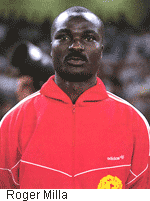 In Italy in 1990, Cameroon achieved the hitherto greatest success by an African national side. The “indomitable lions” led by the thirty-eight year old star Roger Milla won their group and then beat Columbia 2:1 after extra time – so becoming the first African nation to reach the quarter-finals. Against England, Cameroon led 2:1 until eight minutes before the end of normal time but ended up losing 2:3 after extra time. Both England’s equalizer and the winning goal came from penalties, neither of which was uncontroversial.
In Italy in 1990, Cameroon achieved the hitherto greatest success by an African national side. The “indomitable lions” led by the thirty-eight year old star Roger Milla won their group and then beat Columbia 2:1 after extra time – so becoming the first African nation to reach the quarter-finals. Against England, Cameroon led 2:1 until eight minutes before the end of normal time but ended up losing 2:3 after extra time. Both England’s equalizer and the winning goal came from penalties, neither of which was uncontroversial.
At the World Cups of both 1994 and 1998, Nigeria’s Super Eagles made it to the last 16. And in 2002 the surprise qualifier Senegal went one better. Trained by the Frenchman Bruno Metsu, they caused an unprecedented sensation by beating the world champions France 1:0 in the opening match. Twenty-one of the 23-man squad worked for a French employer, prompting France’s keeper Fabian Barthez to complain that his team had played “a side selected from Montpellier and Lorient”. Senegal defeated Sweden 2:1 with a “golden goal” in the play-offs, and only in the quarter-finals were they knocked out by Turkey, again after a “golden goal”.
The irresistible rise of African football
At the 2006 World Cup in Germany, the Africans experienced a setback, with only Ghana reaching the play-offs. This should not be taken to mean that the rise of African football has come to an end, however.
There can be no doubt that many African national sides have been catching up with the Europeans and South Americans. This is not so much thanks to developments in Africa itself, where weak association structures, incompetent officials and corruption dominate the scene, and where youth development work is seriously deficient. Rather, the interest shown in African talent by professional European clubs, some of whom run football academies on the African continent, plus the desire of many African footballers to migrate, has meant that many now play in Europe, often at the leading clubs. For example, in the London derby between Chelsea and Arsenal in March 2008, 13 of the 28 players on the field had an African ethnic background. Only five of the participants were English. Whereas at one time it was assumed that Africans were only suited to being strikers or attacking midfielders, and that “reliability”, “toughness” and “leadership qualities” were attributes to be found only in white footballers, today they play in all positions.
The African national sides have benefited from this too. For instance, of Africa’s 115 national players participating at the 2006 World Cup, 85 played for European clubs. Each and every member of Africa’s strongest team, Ivory Coast, was under contract in Europe, many of them at some of the best addresses: Chelsea, Arsenal, Olympique Marseille, Paris St. Germain and AJ Auxerre.
It has to be said, though, that the high hopes that many people had after Cameroon’s performance in the 1990 World Cup for African success in future tournaments have yet to be fulfilled. On the other hand, recent developments show that African football has long since stepped out of the shadow of its colonial origins. Whereas the Europeans once conquered their continent, African football stars are now “conquering” the European football leagues. And if Africans can some day beat their former colonial masters at their own game and capture football’s most coveted trophy, African football will finally have emancipated itself from its colonial past.

 From an early stage there was close integration with domestic football. French clubs discovered that Algeria and Morocco in particular were excellent recruiting grounds. As early as 1938, 147 Africans were playing in the first and second leagues in France. Some of them, such as the Moroccan Larbi Ben Barek, even played for the national French team. Ben Barek, one of the first great black football stars, began his career at Union Sportive Marocaine of Casablanca, before Olympique Marseille brought him to France in 1938. The maestro, famous for his dribbling skills, subsequently laced his boots for Stade Français Paris (under the legendary coach Helenio Herrera) and Atlético Madrid. And when Olympique Marseille ran out against Racing Club of Paris in the French cup final in 1940, another Olympique player was a certain Ahmed Ben Bella. Twenty years later, Ben Bella became President of the independent Republic of Algeria.
From an early stage there was close integration with domestic football. French clubs discovered that Algeria and Morocco in particular were excellent recruiting grounds. As early as 1938, 147 Africans were playing in the first and second leagues in France. Some of them, such as the Moroccan Larbi Ben Barek, even played for the national French team. Ben Barek, one of the first great black football stars, began his career at Union Sportive Marocaine of Casablanca, before Olympique Marseille brought him to France in 1938. The maestro, famous for his dribbling skills, subsequently laced his boots for Stade Français Paris (under the legendary coach Helenio Herrera) and Atlético Madrid. And when Olympique Marseille ran out against Racing Club of Paris in the French cup final in 1940, another Olympique player was a certain Ahmed Ben Bella. Twenty years later, Ben Bella became President of the independent Republic of Algeria. Like France, Portugal was also relatively quick to recognize the “athletic potential” of its colonies. In the 1950s, the leading Portuguese clubs set up a system of scouts in the colonies of Angola and Mozambique, having repeatedly previously come off second best against local teams during propaganda tours. The great Portuguese star of the 1966 World Cup was Eusebio da Silva Ferreira, who had cut his teeth with Sporting Club Lourenço Marques (today’s Maputo) and now played for Benfica Lisbon. Portugal’s success in getting through to the semi-final that year was largely down to Eusebio, who with his nine goals easily won the trophy for the top goal-scorer.
Like France, Portugal was also relatively quick to recognize the “athletic potential” of its colonies. In the 1950s, the leading Portuguese clubs set up a system of scouts in the colonies of Angola and Mozambique, having repeatedly previously come off second best against local teams during propaganda tours. The great Portuguese star of the 1966 World Cup was Eusebio da Silva Ferreira, who had cut his teeth with Sporting Club Lourenço Marques (today’s Maputo) and now played for Benfica Lisbon. Portugal’s success in getting through to the semi-final that year was largely down to Eusebio, who with his nine goals easily won the trophy for the top goal-scorer. Indirectly, however, Africa had a presence at World Cups in the intervening period thanks to outstanding individual players such as Eusebio or the French player Just Fontaine. Fontaine, who was born in Marrakesh and played for U.S.M. Casablanca from 1951 to 1953, was the top goal-scorer at the 1958 World Cup in Sweden – his tally of 13 goals in a single World Cup has never been bettered to this day. Rachid Mekloufi and Mustafa Zitouni were also in the squad of the Equipe Tricolore for a time, but they left before the start of the World Cup in 1958 to join a team founded by Algerian FLN guerrillas.
Indirectly, however, Africa had a presence at World Cups in the intervening period thanks to outstanding individual players such as Eusebio or the French player Just Fontaine. Fontaine, who was born in Marrakesh and played for U.S.M. Casablanca from 1951 to 1953, was the top goal-scorer at the 1958 World Cup in Sweden – his tally of 13 goals in a single World Cup has never been bettered to this day. Rachid Mekloufi and Mustafa Zitouni were also in the squad of the Equipe Tricolore for a time, but they left before the start of the World Cup in 1958 to join a team founded by Algerian FLN guerrillas. In 1966 the African teams boycotted the qualification rounds, because the European-dominated FIFA had reserved only one single slot for Asia and Africa together. As a result of this protest, a permanent slot was reserved specifically for Africa in the World Cup in Mexico in 1970. Morocco put in a thoroughly respectable performance that year, taking the lead against Germany but eventually losing a close match 1:2. Against Bulgaria they drew 1:1 – gaining the first point ever for an African team in a World Cup. After a catastrophic performance by Zaire at the 1974 World Cup in Germany, a Tunisian team coached by Mejid Chetail (a pupil of the German trainer Hennes Weisweiler) chalked up the first ever victory for an African team in a World Cup in Argentina in 1978. After beating Mexico 3:1, they drew 0:0 against title-holders Germany and were narrowly defeated by Poland 0:1, and so were unluckily eliminated after coming third in their group.
In 1966 the African teams boycotted the qualification rounds, because the European-dominated FIFA had reserved only one single slot for Asia and Africa together. As a result of this protest, a permanent slot was reserved specifically for Africa in the World Cup in Mexico in 1970. Morocco put in a thoroughly respectable performance that year, taking the lead against Germany but eventually losing a close match 1:2. Against Bulgaria they drew 1:1 – gaining the first point ever for an African team in a World Cup. After a catastrophic performance by Zaire at the 1974 World Cup in Germany, a Tunisian team coached by Mejid Chetail (a pupil of the German trainer Hennes Weisweiler) chalked up the first ever victory for an African team in a World Cup in Argentina in 1978. After beating Mexico 3:1, they drew 0:0 against title-holders Germany and were narrowly defeated by Poland 0:1, and so were unluckily eliminated after coming third in their group. In Italy in 1990, Cameroon achieved the hitherto greatest success by an African national side. The “indomitable lions” led by the thirty-eight year old star Roger Milla won their group and then beat Columbia 2:1 after extra time – so becoming the first African nation to reach the quarter-finals. Against England, Cameroon led 2:1 until eight minutes before the end of normal time but ended up losing 2:3 after extra time. Both England’s equalizer and the winning goal came from penalties, neither of which was uncontroversial.
In Italy in 1990, Cameroon achieved the hitherto greatest success by an African national side. The “indomitable lions” led by the thirty-eight year old star Roger Milla won their group and then beat Columbia 2:1 after extra time – so becoming the first African nation to reach the quarter-finals. Against England, Cameroon led 2:1 until eight minutes before the end of normal time but ended up losing 2:3 after extra time. Both England’s equalizer and the winning goal came from penalties, neither of which was uncontroversial.

